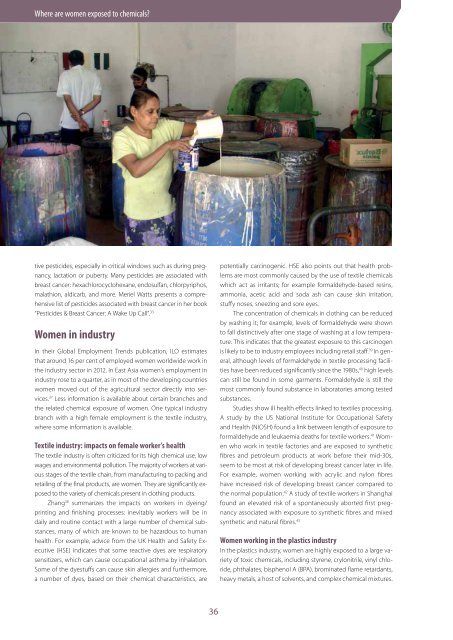Women and Chemicals
1ToENNR
1ToENNR
Create successful ePaper yourself
Turn your PDF publications into a flip-book with our unique Google optimized e-Paper software.
Where are women exposed to chemicals?<br />
tive pesticides, especially in critical windows such as during pregnancy,<br />
lactation or puberty. Many pesticides are associated with<br />
breast cancer: hexachlorocyclohexane, endosulfan, chlorpyriphos,<br />
malathion, aldicarb, <strong>and</strong> more. Meriel Watts presents a comprehensive<br />
list of pesticides associated with breast cancer in her book<br />
“Pesticides & Breast Cancer: A Wake Up Call”. 33<br />
<strong>Women</strong> in industry<br />
In their Global Employment Trends publication, ILO estimates<br />
that around 16 per cent of employed women worldwide work in<br />
the industry sector in 2012. In East Asia women’s employment in<br />
industry rose to a quarter, as in most of the developing countries<br />
women moved out of the agricultural sector directly into services.<br />
37 Less information is available about certain branches <strong>and</strong><br />
the related chemical exposure of women. One typical industry<br />
branch with a high female employment is the textile industry,<br />
where some information is available.<br />
Textile industry: impacts on female worker’s health<br />
The textile industry is often criticized for its high chemical use, low<br />
wages <strong>and</strong> environmental pollution. The majority of workers at various<br />
stages of the textile chain, from manufacturing to packing <strong>and</strong><br />
retailing of the final products, are women. They are significantly exposed<br />
to the variety of chemicals present in clothing products.<br />
Zhang 38 summarizes the impacts on workers in dyeing/<br />
printing <strong>and</strong> finishing processes: inevitably workers will be in<br />
daily <strong>and</strong> routine contact with a large number of chemical substances,<br />
many of which are known to be hazardous to human<br />
health. For example, advice from the UK Health <strong>and</strong> Safety Executive<br />
(HSE) indicates that some reactive dyes are respiratory<br />
sensitizers, which can cause occupational asthma by inhalation.<br />
Some of the dyestuffs can cause skin allergies <strong>and</strong> furthermore,<br />
a number of dyes, based on their chemical characteristics, are<br />
potentially carcinogenic. HSE also points out that health problems<br />
are most commonly caused by the use of textile chemicals<br />
which act as irritants; for example formaldehyde-based resins,<br />
ammonia, acetic acid <strong>and</strong> soda ash can cause skin irritation,<br />
stuffy noses, sneezing <strong>and</strong> sore eyes.<br />
The concentration of chemicals in clothing can be reduced<br />
by washing it; for example, levels of formaldehyde were shown<br />
to fall distinctively after one stage of washing at a low temperature.<br />
This indicates that the greatest exposure to this carcinogen<br />
is likely to be to industry employees including retail staff. 39 In general,<br />
although levels of formaldehyde in textile processing facilities<br />
have been reduced significantly since the 1980s, 40 high levels<br />
can still be found in some garments. Formaldehyde is still the<br />
most commonly found substance in laboratories among tested<br />
substances.<br />
Studies show ill health effects linked to textiles processing.<br />
A study by the US National Institute for Occupational Safety<br />
<strong>and</strong> Health (NIOSH) found a link between length of exposure to<br />
formaldehyde <strong>and</strong> leukaemia deaths for textile workers. 41 <strong>Women</strong><br />
who work in textile factories <strong>and</strong> are exposed to synthetic<br />
fibres <strong>and</strong> petroleum products at work before their mid-30s,<br />
seem to be most at risk of developing breast cancer later in life.<br />
For example, women working with acrylic <strong>and</strong> nylon fibres<br />
have increased risk of developing breast cancer compared to<br />
the normal population. 42 A study of textile workers in Shanghai<br />
found an elevated risk of a spontaneously aborted first pregnancy<br />
associated with exposure to synthetic fibres <strong>and</strong> mixed<br />
synthetic <strong>and</strong> natural fibres. 43<br />
<strong>Women</strong> working in the plastics industry<br />
In the plastics industry, women are highly exposed to a large variety<br />
of toxic chemicals, including styrene, crylonitrile, vinyl chloride,<br />
phthalates, bisphenol A (BPA), brominated flame retardants,<br />
heavy metals, a host of solvents, <strong>and</strong> complex chemical mixtures.<br />
36


